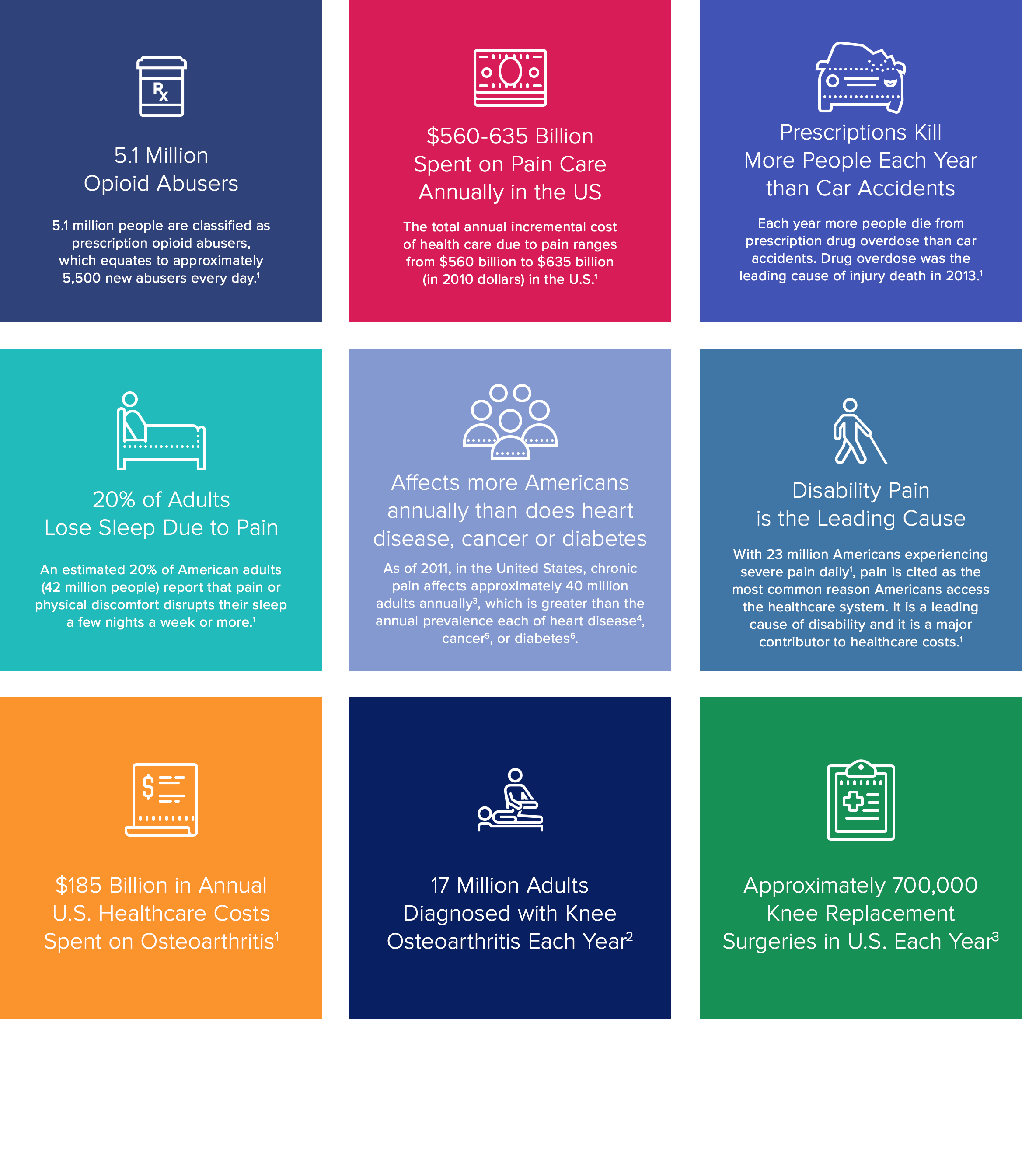Centrexion Therapeutics is building a pain treatment powerhouse to address this substantial and growing global chronic pain epidemic. We seek to develop and commercialize novel, non-opioid, non-steroidal medicines that can safely and effectively treat the significant unmet medical need of chronic pain.
What is Chronic Pain?
Pain is a necessary protective reaction that alerts the body to the presence of actual or potential tissue damage so that necessary corrective responses can be activated. Pain is signaled by specialized cells in the peripheral nervous system called nociceptors, or pain fibers. These pain fibers normally transmit information from different locations in the body to the brain about stimuli that approach or exceed harmful intensity which, in turn, results in the sensation of pain.
“Pain is part of the human condition; at some point, for short or long periods of time, we all experience pain and suffer its consequences. While pain can serve as a warning to protect us from further harm, it also can contribute to severe and even relentless suffering, surpassing its underlying cause to become a disease in its own domains and dimensions.”
– Committee on Advancing Pain Research, Care, and Education Board on Health Sciences Policy, 20111
“Pain…when it becomes intractable, it no longer serves a useful purpose and then becomes, through its mental and physical effects, a destructive force.”
– Dr. John J Bonica, ‘founding father’ of pain management2
Pain is a necessary protective reaction that alerts the body to the presence of actual or potential tissue damage so that necessary corrective responses can be mounted. Pain is signaled by specialized cells in the peripheral nervous system called nociceptors, or pain-sensing fibers. These pain-sensing fibers normally transmit information from different locations in the body to the brain about stimuli that approach or exceed harmful intensity which, in turn, results in the sensation of pain.
The National Institutes of Health, or NIH, defines chronic pain as pain that persists beyond the normal healing time of an injury or that persists for longer than three months,. Chronic pain is a highly complex and often misunderstood medical condition affecting every aspect of a person’s life and contributing to a loss of both physical and emotional function. People suffering from chronic pain experience diminishing levels of activity, productivity, social relationships and overall well-being and have an increased risk of early mortality.4
Current neuroscience confirms that chronic pain is more than a symptom of an underlying disease, but a disease in its own right. Imaging and non-imaging studies demonstrate substantial functional, structural and chemical changes in the brains and bodies of patients suffering from chronic pain.3

Why Chronic Pain?
The unmet clinical need in treating chronic pain reflects the failure to develop novel classes of analgesics with comparable or greater efficacy, an acceptable level of adverse effects and a lower abuse liability than those currently available.
As of 2011, over 40 million adults in the United States and over 1 billion people worldwide suffer from chronic pain each year.5 This epidemic extracts a tremendous cost in terms of direct treatment and rehabilitation expenditures, lost worker productivity, prevalent addiction to opioid-based drugs, and emotional and financial burden for patients and their families. According to an Institute of Medicine of the National Academies report, pain in the United States costs society between $560 and $635 billion annually – higher than the three other leading causes of disability/death combined.1
Opioids are some of the most widely prescribed therapeutics for serious pain, with sales quadrupling between 1999 and 2010. According to a National Survey on Drug Use and Health report, in 2016 more than one third of adult Americans were prescribed opioids and 230 million opioid prescriptions were written that year in the United States.
Opioids, however, are associated with significant side effects, particularly when administered chronically. Drug and alcohol addiction – often linked to the misuse of medications prescribed for chronic pain – affects more than 23 million in the U.S. each year.1 Despite the significant effects of chronic pain on the U.S. population and economy, investment in the development of options for treating it – and associated issues like addiction – is extremely low. Less than $2B was invested in venture research and development for alternative pain treatments in the last decade compared to the nearly $12B spent on cancer.3
Currently available non-opioid treatments, while avoiding the abuse and addiction issues associated with opioid treatments, offer limited pain relief and are often accompanied by significant risks such as gastrointestinal, cardiovascular, central nervous system, renal and other adverse effects, including organ failure and death.
1Gaskin, D, Richard, P. 2011. Relieving Pain in America: A Blueprint for Transforming Prevention, Care, Education, and Research. The Economic Costs of Pain in the United States. Institute of Medicine (US) Committee on Advancing Pain Research, Care, and Education. Washington (DC): National Academies Press (US).
2Bonica JJ. 1953. The Management of Pain. Philadelphia, PA: Lea and Febirger publishers.
3Turk DC, et al, 2011. Lancet. Jun 25; 377(9784):2226-35.
4Torrance N, et al, 2010. Eur J Pain. Apr; 14(4):380-6.
5http://www.painmed.org/patientcenter/facts_on_pain.aspx, Last accessed December 21, 2017